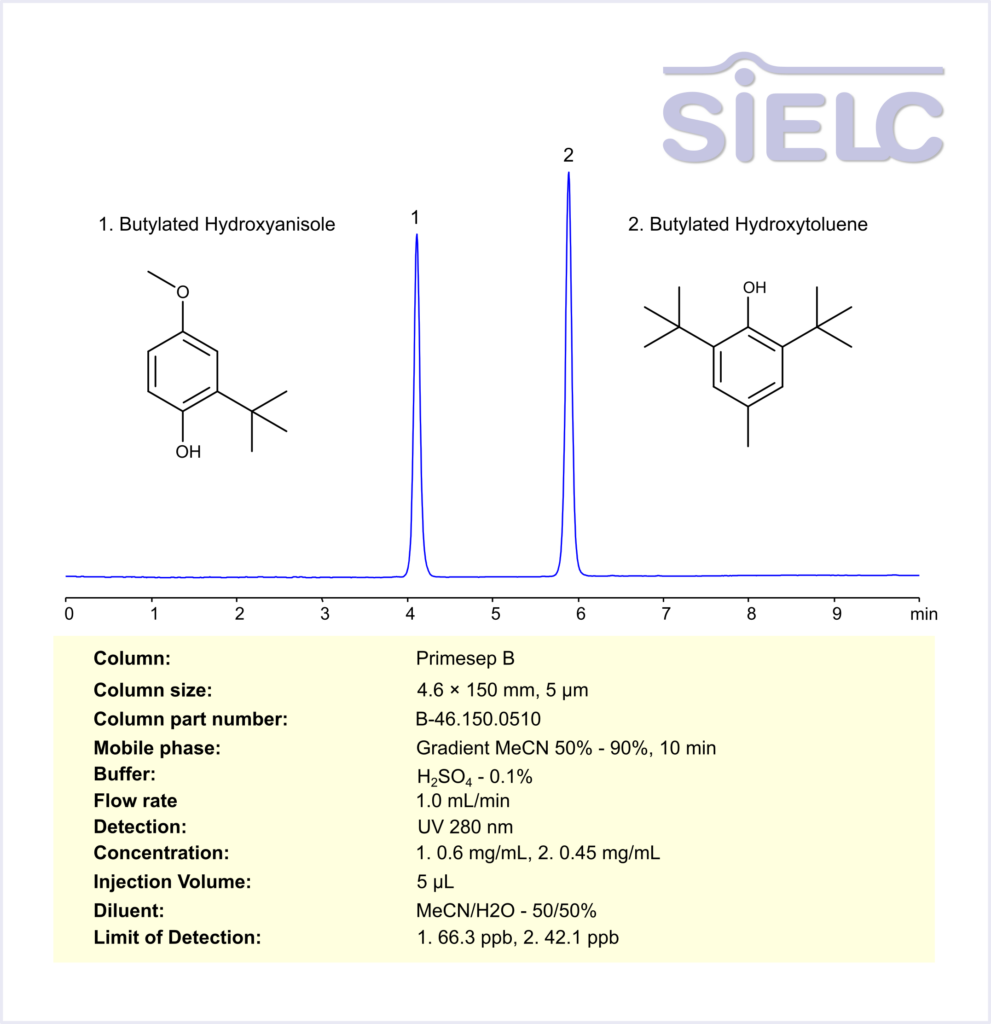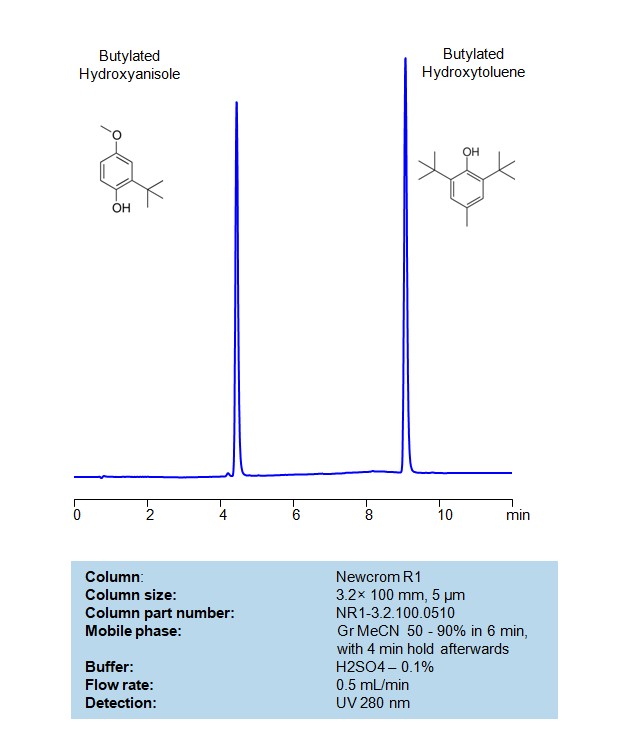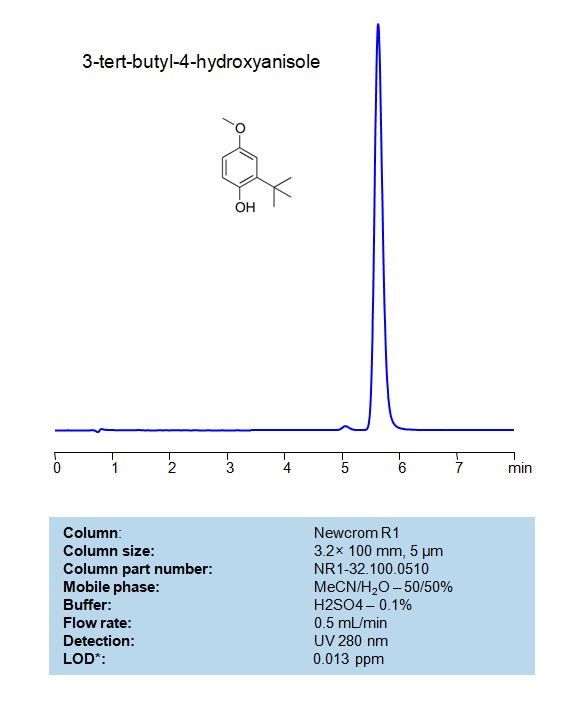
| CAS Number | 121-00-6 |
|---|---|
| Molecular Formula | C11H16O2 |
| Molecular Weight | 180.24 |
| InChI Key | MRBKEAMVRSLQPH-UHFFFAOYSA-N |
| LogP | 3.2 |
| Synonyms |
|
Applications:
HPLC Method for Analysis of Butylated Hydroxytoluene (BHT) and Butylated Hydroxyanisole (BHA) on Primesep B Column
February 6, 2025
HPLC Method for Butylated hydroxytoluene, 3-tert-butyl-4-hydroxyanisole (BHA) on Primesep B by SIELC Technologies

High Performance Liquid Chromatography (HPLC) Method for Analysis of Butylated hydroxytoluene, 3-tert-butyl-4-hydroxyanisole (BHA)
Butylated Hydroxytoluene (BHT) and Butylated Hydroxyanisole (BHA) are synthetic antioxidants commonly used to prevent oxidation, which can lead to spoilage, rancidity, and loss of flavor in food, cosmetics, and pharmaceuticals.
BHT is a fat-soluble compound that helps maintain the freshness of oils, fats, and processed foods by preventing them from oxidizing and becoming rancid. It is also used in some cosmetics and industrial products.
BHA is often found in processed foods, snacks, and animal feed. It helps preserve the quality of products by preventing oxidative damage that can affect flavor, color, and texture.
While both BHT and BHA are effective at prolonging the shelf life of products, concerns have been raised about their potential health risks when consumed in large quantities over time, prompting ongoing research and regulatory reviews.
Butylated hydroxytoluene, 3-tert-butyl-4-hydroxyanisole (BHA) can be retained and analyzed using the Primesep B stationary phase column. The analysis utilizes a gradient method with a simple mobile phase consisting of water, acetonitrile (MeCN), and sulfuric acid. Detection is performed using UV at 280 nm.
| Column | Primesep B, 4.6 x 150 mm, 5 µm, 100 A, dual ended |
| Mobile Phase | Gradient MeCN 50 – 90%, 10 min |
| Buffer | H2SO4 – 0.1% |
| Flow Rate | 1.0 ml/min |
| Detection | UV 280 nm |
| LOD | 1. 66.3 ppb, 2. 42.1 ppb |
*LOD was determined for this combination of instrument, method, and analyte, and it can vary from one laboratory to another even when the same general type of analysis is being performed.
| Class of Compounds | Phenolic Antioxidants |
| Analyzing Compounds | Butylated hydroxytoluene, 3-tert-butyl-4-hydroxyanisole (BHA) |
Application Column
Primesep B
Column Diameter: 4.6 mm
Column Length: 150 mm
Particle Size: 5 µm
Pore Size: 100 A
Column options: dual ended
Butylated hydroxytoluene

HPLC Method for Separation BHA and BHT on Newcrom R1 Column
March 1, 2024
HPLC Method for Analysis of Butylated hydroxytoluene, 3-tert-butyl-4-hydroxyanisole (BHA) on Newcrom R1 Column by SIELC Technologies
Separation type: Liquid Chromatography Reversed-phase

3-tert-butyl-4-hydroxyanisole (BHA) is a synthetic antioxidant commonly used as a food preservative. It is an aromatic compound with the chemical formula C11H16O2. BHA belongs to a class of compounds known as butylated hydroxyanisoles.
Function: BHA is used as an antioxidant to prevent the spoilage of fats and oils in various food products. It helps protect these substances from oxidative degradation, extending the shelf life of processed foods.
Chemical Structure: The compound has a molecular structure with a tert-butyl group (tert-butyl radical) attached to the oxygen atom of a hydroxyanisole group. The IUPAC name for BHA is 2-tert-butyl-4-methoxyphenol.
Usage: BHA is commonly used in a variety of food products, including snack foods, baked goods, cereals, and fats and oils. It is also used in certain cosmetic and pharmaceutical products.
Butylated Hydroxytoluene (BHT) is a synthetic antioxidant belonging to the class of compounds known as butylated hydroxytoluenes. Like BHA (butylated hydroxyanisole), BHT is commonly used as a food preservative to prevent the oxidation of fats and oils in various processed foods. It is also used in other products, including cosmetics, pharmaceuticals, and industrial applications.
Function: BHT acts as an antioxidant by inhibiting the oxidation of fats and oils. It helps prevent the development of off-flavors and odors in foods, extending their shelf life.
Usage: BHT is commonly used in a variety of food products, including snacks, cereals, baked goods, and processed meats. It is also used in some cosmetic and personal care products and in the packaging of certain products to prevent oxidation.
BHA and BHT can be retained, separated and analyzed on a reversed-phase Newcrom R1 column with a mobile phase consisting of water, Acetonitrile (MeCN), and sulfuric acid. This analytical method can be detected with high resolution and peak symmetry at a wavelength of 280 nm using UV detection
High Performance Liquid Chromatography (HPLC) Method for Analyses of Butylated hydroxytoluene, 3-tert-butyl-4-hydroxyanisole (BHA) on Newcrom R1 Column by SIELC Technologies
Condition
| Column | Newcrom R1, 3.2 x 100 mm, 5 µm, 100 A, dual ended |
| Mobile Phase | Gradient MeCN – 50 -90%, 6 min, 4 min hold |
| Buffer | H2SO4 – 0.1% |
| Flow Rate | 0.5 ml/min |
| Detection | UV 280 nm |
| Injection volume: | 1 µL |
| Sample | 1 mg/ml |
| Sample Diluent | MeCN/H2O – 50/50% |
Description
| Class of Compounds | butylated hydroxyanisoles (BHAs) |
| Analyzing Compounds | Butylated hydroxytoluene, 3-tert-butyl-4-hydroxyanisole (BHA) |
Application Column
Newcrom R1
Column Diameter: 3.2 mm
Column Length: 100 mm
Particle Size: 5 µm
Pore Size: 100 A
Column options: dual ended
Butylated hydroxytoluene

HPLC Method for Analysis of 3-tert-butyl-4-hydroxyanisole (BHA) on Newcrom R1 Column
February 29, 2024
HPLC Method for Analysis of 3-tert-butyl-4-hydroxyanisole (BHA) on Newcrom R1 Column by SIELC Technologies
Separation type: Liquid Chromatography Reversed-phase

3-tert-butyl-4-hydroxyanisole (BHA) is a synthetic antioxidant commonly used as a food preservative. It is an aromatic compound with the chemical formula C11H16O2. BHA belongs to a class of compounds known as butylated hydroxyanisoles.
Function: BHA is used as an antioxidant to prevent the spoilage of fats and oils in various food products. It helps protect these substances from oxidative degradation, extending the shelf life of processed foods.
Chemical Structure: The compound has a molecular structure with a tert-butyl group (tert-butyl radical) attached to the oxygen atom of a hydroxyanisole group. The IUPAC name for BHA is 2-tert-butyl-4-methoxyphenol.
Usage: BHA is commonly used in a variety of food products, including snack foods, baked goods, cereals, and fats and oils. It is also used in certain cosmetic and pharmaceutical products.
3-tert-butyl-4-hydroxyanisole (BHA) be retained and analyzed on a reversed-phase Newcrom R1 column with a mobile phase consisting of water, Acetonitrile (MeCN), and sulfuric acid. This analytical method can be detected with high resolution and peak symmetry at a wavelength of 280 nm using UV detection
High Performance Liquid Chromatography (HPLC) Method for Analyses of 3-tert-butyl-4-hydroxyanisole (BHA) on Newcrom R1 Column by SIELC Technologies
Condition
| Column | Newcrom R1, 3.2 x 100 mm, 5 µm, 100 A, dual ended |
| Mobile Phase | MeCN – 50% |
| Buffer | H2SO4 – 0.1% |
| Flow Rate | 0.5 ml/min |
| Detection | UV 280 nm |
| Injection volume: | 1 µL |
| Sample | 1 mg/ml |
| Sample Diluent | MeCN/H2O – 50/50% |
| LOD* | 0.0135 ppm |
Description
| Class of Compounds | butylated hydroxyanisoles (BHAs) |
| Analyzing Compounds | 3-tert-butyl-4-hydroxyanisole (BHA) |
Application Column
Newcrom R1
Column Diameter: 3.2 mm
Column Length: 100 mm
Particle Size: 5 µm
Pore Size: 100 A
Column options: dual ended



